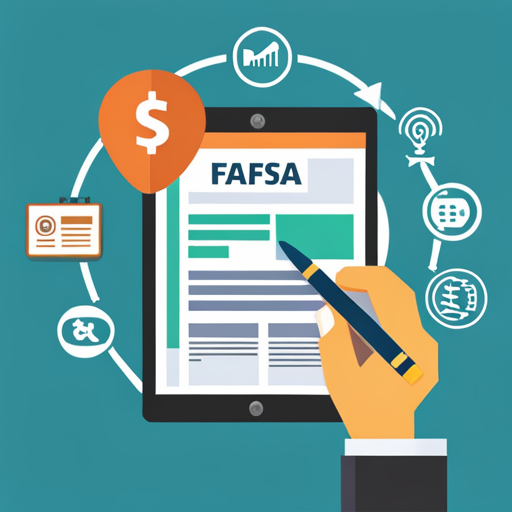"Cherishing Little Steps - A Haven for Baby and Family Journeys"
FASFA for High Schoolers
Are you feeling lost in the sea of financial aid options for college? Look no further!
FASFA for High Schoolers is here to guide you through the process of applying for federal student aid. We know how overwhelming it can be to navigate the world of financial assistance, but don’t worry, we’ve got your back.
Our comprehensive guide will help you understand the eligibility requirements, gather the necessary documents, and decode those confusing financial terms on the FAFSA form.
We’ll also provide you with tips to maximize your financial aid potential and resources for additional assistance.
So, put your worries aside and let FASFA for High Schoolers be your compass towards a brighter future.
Eligibility Requirements for FAFSA

To determine if you qualify for FAFSA, you’ll need to meet certain eligibility requirements. The FAFSA eligibility criteria include:
- Being a U.S. citizen or an eligible non-citizen
- Having a valid Social Security number
- Demonstrating financial need
Financial need is determined by FAFSA income requirements, which take into account your family’s income and assets. For the 2021-2022 academic year, the income threshold to qualify for FAFSA is $26,000 for a family of four. However, it’s crucial to remember that these income limits can vary from year to year, so it’s essential to stay up to date with the current requirements.
In addition to meeting the income requirements, you must also:
- Have a high school diploma or GED
- Be enrolled or accepted into an eligible degree or certificate program
- Maintain satisfactory academic progress
If you meet these criteria, you have a good chance of qualifying for FAFSA. Remember, FAFSA is a valuable resource that can provide financial assistance for your education. Make sure to carefully review the eligibility requirements and gather all necessary documents to complete the application accurately.
Understanding the FAFSA Application Process

Start by familiarizing yourself with the FAFSA application process. Understanding the FAFSA application process is crucial when it comes to securing financial aid for college. The first step is to gather all the necessary documents, such as your Social Security number, driver’s license, and tax returns. Next, you’ll need to create an FSA ID, which serves as your electronic signature for the FAFSA. Once you have your documents ready and your FSA ID created, you can fill out the FAFSA online.
The FAFSA application consists of several sections, including personal information, financial information, and a list of schools you’re interested in attending. It’s important to be thorough and accurate when filling out these sections to ensure that you receive the maximum amount of financial aid possible.
To simplify the FAFSA requirements, you can use the IRS Data Retrieval Tool (DRT) to transfer your tax information directly to the FAFSA. This can save you time and reduce the likelihood of errors.
After submitting your FAFSA, you’ll receive a Student Aid Report (SAR) which summarizes the information you provided. Review your SAR carefully and make any necessary corrections. Once your FAFSA is processed, you’ll receive financial aid offers from the schools you listed on your application.
Understanding the FAFSA application process and simplifying the requirements can help you navigate the financial aid process more efficiently and increase your chances of receiving the financial assistance you need for college.
Tips for Gathering Necessary Documents

Once you have familiarized yourself with the FAFSA application process, it’s essential to efficiently gather the necessary documents. To help you in this process, here are some tips for organization that will make gathering the required paperwork a breeze.
Firstly, create a checklist of all the documents you need. This will help you stay organized and ensure you don’t miss anything. The FAFSA website provides a helpful checklist that you can use as a starting point.
Next, gather all your personal and financial information. This includes your Social Security number, driver’s license, and tax returns for both you and your parents. It’s also important to have documentation of any untaxed income, such as child support or veteran’s benefits.
Keep all your documents in a safe and secure place. Consider using a folder or binder specifically for your FAFSA materials. This will make it easier to find what you need when it comes time to complete the application.
Lastly, make copies of all your documents. This is crucial in case anything gets lost or misplaced. Having backups will save you time and stress in the long run.
Important Deadlines for Submitting FAFSA

When it comes to submitting your FAFSA, it’s crucial to be aware of the important deadlines. Missing these deadlines could result in a loss of financial aid opportunities, so it’s important to stay on top of them.
Here are some important FAFSA deadlines and tips to help you navigate the application process:
-
Federal Deadline: The deadline for submitting the FAFSA for federal aid is typically June 30th, but it’s best to submit as early as possible to maximize your chances of receiving aid.
-
State Deadline: Each state has its own deadline for state-specific financial aid programs. Make sure to check your state’s deadline and submit your FAFSA accordingly.
-
Early Filing: Some states have early filing deadlines, which means you need to submit your FAFSA earlier than the federal deadline to be considered for state aid.
-
Priority Deadlines: Many states have priority deadlines, which determine the order in which financial aid is awarded. Submitting your FAFSA before the priority deadline can increase your chances of receiving aid.
FAFSA Application Tips:
-
Use the IRS Data Retrieval Tool: This tool allows you to transfer your tax information directly from the IRS to your FAFSA, making the application process faster and more accurate.
-
Double-check your information: Mistakes on your FAFSA can delay the processing of your application. Take the time to review your information before submitting.
-
Submit on time: Meeting the deadlines is crucial. Submit your FAFSA early to ensure you don’t miss out on any potential aid.
How to Navigate the FAFSA Website

To successfully navigate the FAFSA website, it’s important that you familiarize yourself with its features and resources. The website is designed to help you complete your FAFSA application efficiently and effectively.
When you first visit the website, you’ll see a homepage that provides an overview of the FAFSA process and important information about financial aid. You can access different sections of the website by using the navigation menu at the top of the page. This menu allows you to easily find the information you need, such as eligibility requirements, deadlines, and application tips.
If you encounter any issues or have questions while navigating the website, there are resources available to help you. The FAFSA website provides a comprehensive FAQ section where you can find answers to common questions and troubleshooting tips. Additionally, you can contact the FAFSA helpline or reach out to your school’s financial aid office for assistance.
Common Mistakes to Avoid When Filling Out FAFSA

Avoiding common mistakes is crucial when filling out the FAFSA application. Making errors can delay the processing of your financial aid and potentially cost you valuable opportunities. To ensure a smooth application process, here are some common mistakes to avoid when filling out the FAFSA:
-
Providing incorrect personal information:
-
Double-check your name, date of birth, and Social Security number for accuracy.
-
Ensure that you enter your address correctly, including any apartment or unit numbers.
-
Failing to report all sources of income:
-
Include all income sources, such as wages, self-employment income, and untaxed income.
-
Don’t forget to report any income earned by your parents or spouse, if applicable.
-
Neglecting to update information:
-
Update any changes to your financial situation promptly.
-
Notify the FAFSA office of any changes in your family’s financial circumstances.
-
Leaving fields blank:
-
Fill out every question on the FAFSA, even if the answer is zero or doesn’t apply to you.
-
Use the IRS Data Retrieval Tool to transfer accurate tax information directly from the IRS.
Decoding Financial Terms on the FAFSA Form

Understanding financial terms on the FAFSA form is essential for high schoolers to accurately complete their financial aid application. Two important terms to understand are FAFSA income limits and FAFSA dependency status.
FAFSA income limits refer to the maximum income a student or their family can have in order to be eligible for federal financial aid. These limits are determined by the U.S. Department of Education and are updated annually. It’s important to be aware of these limits, as exceeding them may affect your eligibility for certain types of aid.
FAFSA dependency status is another crucial term to understand. It determines whether a student is considered dependent or independent for financial aid purposes. Dependency status is based on various factors, including age, marital status, and level of financial support provided by parents. Understanding your dependency status is important, as it can affect the amount of financial aid you’re eligible to receive.
Maximizing Your Financial Aid Potential

Now, let’s focus on how you can make the most of your financial aid potential.
Maximizing your financial aid is crucial when it comes to funding your education. Here are some strategies for financial planning that can help you maximize your financial aid:
-
Start early: Begin researching scholarships and grants as soon as possible. Many opportunities have early deadlines, so it’s important to stay organized and submit your applications on time.
-
Complete the FAFSA accurately: The Free Application for Federal Student Aid (FAFSA) is the key to unlocking financial aid. Make sure you provide all the necessary information and double-check your answers to avoid any mistakes.
-
Explore all options: Don’t limit yourself to just federal aid. Look into state grants, institutional scholarships, and private funding opportunities. Every dollar counts, so cast a wide net and apply for as many scholarships and grants as possible.
-
Consider your financial situation: If your family’s financial situation has changed since you completed the FAFSA, reach out to the financial aid office to discuss your circumstances. They may be able to reassess your financial aid package based on your current needs.
-
Stay informed: Keep track of important financial aid deadlines and stay updated on any changes in government regulations or institutional policies. This will ensure that you don’t miss out on any opportunities for financial aid.
Additional Resources for FAFSA Assistance

If you’re looking for extra help with the FAFSA, there are plenty of resources available to assist you. One of the best sources of additional support is online resources. These resources provide valuable information and guidance to help you navigate the FAFSA application process.
One online resource worth exploring is the Federal Student Aid website. This website offers a wealth of information about the FAFSA, including step-by-step instructions, tips for completing the application accurately, and answers to frequently asked questions. They also provide helpful resources such as videos and infographics to make the process easier to understand.
Another online resource to consider is the FAFSA Help Center. This website provides comprehensive guidance and support for students and parents filling out the FAFSA. They offer live chat assistance, email support, and a toll-free hotline to address any questions or concerns you may have.
In addition to these online resources, many colleges and universities have financial aid offices that can provide personalized assistance with the FAFSA. These offices often offer workshops and one-on-one counseling sessions to help students and their families complete the application correctly.
Planning for College Expenses Beyond FAFSA

To effectively plan for college expenses beyond FAFSA, consider exploring various funding options available to you. Here are some planning strategies and cost-saving tips to help you navigate the financial aspects of college:
-
Scholarships and Grants:
-
Research and apply for scholarships and grants offered by colleges, organizations, and foundations. These can provide significant financial aid and reduce your overall college costs.
-
Keep track of application deadlines and requirements to ensure you don’t miss out on any potential funding opportunities.
-
Work-Study Programs:
-
Consider participating in a work-study program offered by your college. These programs allow you to work part-time on campus while pursuing your studies, providing you with a source of income to help cover your expenses.
-
Budgeting and Saving:
-
Create a budget to track your income and expenses. This will help you prioritize your spending and identify areas where you can cut back and save money.
-
Start saving early by setting aside a portion of your income or any extra funds you receive. Even small amounts can add up over time and contribute towards your college expenses.
By exploring these funding options, taking advantage of work-study programs, and implementing budgeting and saving strategies, you can better plan for college expenses beyond FAFSA.
Remember to stay proactive in your financial planning and seek assistance from financial aid offices or college counselors if needed.
Frequently Asked Questions
Can I Apply for FAFSA if I Am an International Student?
Yes, as an international student, you can apply for FAFSA. However, non-US citizens may have different eligibility requirements. Check the FAFSA website for specific information on international student eligibility and FAFSA requirements for non-US citizens.
What Happens if I Miss the FAFSA Deadline?
If you miss the FAFSA deadline, consequences may include losing out on financial aid opportunities. However, there are alternatives like applying for scholarships or seeking out other forms of assistance to help fund your education.
Can I Update My FAFSA Information After Submitting It?
Yes, you can update your FAFSA information after submitting it. However, it’s crucial to meet the deadline to avoid missing out on financial aid opportunities. Keep track of deadlines and make necessary updates promptly.
How Do I Report My Parents’ Income if They Are Divorced or Separated?
When your parents are divorced or separated, reporting their income for financial aid eligibility can be tricky. Make sure to include both parents’ financial information and any child support or alimony received.
Can I Receive Financial Aid if I Am Attending a Vocational or Trade School Instead of a Traditional College or University?
You can receive financial aid for vocational or trade schools. There are different financial aid options available for these schools compared to traditional colleges. It’s important to explore all your options and apply for aid through FAFSA.
Conclusion
Congratulations on completing the FAFSA! By submitting this application, you have taken an important step towards securing financial aid for your college education.
Did you know that in the 2019-2020 academic year, over 18 million students completed the FAFSA? That’s enough students to fill 200 football stadiums!
Remember, financial aid is crucial in making your college dreams a reality, so make sure to take advantage of all the resources available to you.
Good luck on your college journey!



pharmacies in mexico that ship to usa
https://cmqpharma.com/# buying prescription drugs in mexico online
mexican pharmaceuticals online
mexico drug stores pharmacies: cmqpharma.com – mexican pharmaceuticals online
https://indiapharmast.com/# india pharmacy
pharmacies in mexico that ship to usa [url=https://foruspharma.com/#]п»їbest mexican online pharmacies[/url] mexican pharmaceuticals online
canada drugs online: buy canadian drugs – canadianpharmacymeds com
cheapest online pharmacy india [url=http://indiapharmast.com/#]indian pharmacy paypal[/url] indian pharmacy
http://foruspharma.com/# mexico drug stores pharmacies
Online medicine home delivery: best india pharmacy – indian pharmacy paypal
mexico drug stores pharmacies [url=https://foruspharma.com/#]best online pharmacies in mexico[/url] mexican pharmacy
http://canadapharmast.com/# legit canadian online pharmacy
mexico drug stores pharmacies: buying prescription drugs in mexico online – buying from online mexican pharmacy
canadian pharmacy 24 com [url=https://canadapharmast.com/#]drugs from canada[/url] canada drugs
my canadian pharmacy rx: reddit canadian pharmacy – canadian pharmacy cheap
https://clomiddelivery.pro/# cost generic clomid pills
http://doxycyclinedelivery.pro/# doxycycline brand in india
can i order clomid online [url=https://clomiddelivery.pro/#]how can i get cheap clomid without prescription[/url] where can i get generic clomid now
https://paxloviddelivery.pro/# paxlovid pharmacy
http://clomiddelivery.pro/# where can i buy generic clomid without insurance
how to buy clomid without rx [url=https://clomiddelivery.pro/#]cost cheap clomid without dr prescription[/url] cost clomid pills
https://clomiddelivery.pro/# buy generic clomid without prescription
http://clomiddelivery.pro/# cost generic clomid without dr prescription
https://doxycyclinedelivery.pro/# buy doxycycline india
where can i get generic clomid without rx [url=https://clomiddelivery.pro/#]where to get generic clomid pill[/url] cost cheap clomid without prescription
https://paxloviddelivery.pro/# paxlovid for sale
http://ciprodelivery.pro/# ciprofloxacin
paxlovid pharmacy [url=http://paxloviddelivery.pro/#]paxlovid cost without insurance[/url] paxlovid buy
http://paxloviddelivery.pro/# Paxlovid buy online
https://ciprodelivery.pro/# ciprofloxacin over the counter
cipro online no prescription in the usa [url=https://ciprodelivery.pro/#]buy ciprofloxacin[/url] antibiotics cipro
https://paxloviddelivery.pro/# paxlovid cost without insurance
https://amoxildelivery.pro/# amoxicillin order online
purchase cipro [url=https://ciprodelivery.pro/#]ciprofloxacin[/url] buy ciprofloxacin
https://clomiddelivery.pro/# where to buy generic clomid no prescription
http://amoxildelivery.pro/# buy amoxicillin
discount doxycycline [url=https://doxycyclinedelivery.pro/#]doxycycline 100 mg pill[/url] buy cheap doxycycline
https://clomiddelivery.pro/# can i purchase generic clomid pills